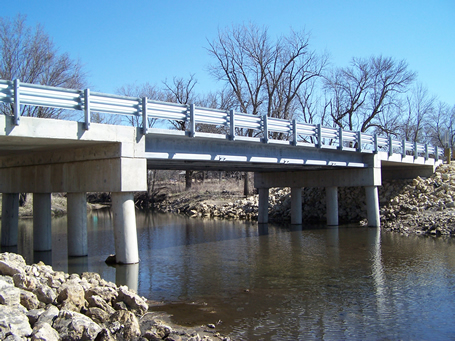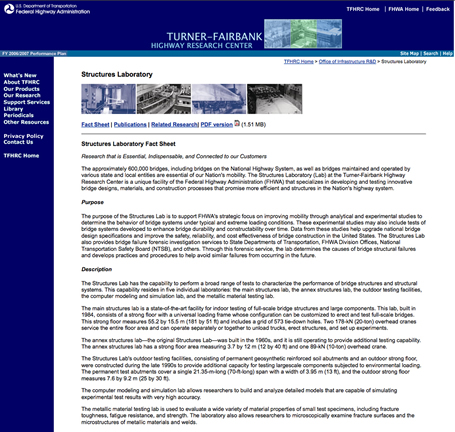U.S. Department of Transportation
Federal Highway Administration
1200 New Jersey Avenue, SE
Washington, DC 20590
202-366-4000
Focus
| Accelerating Infrastructure Innovations |
Publication Number: FHWA-HRT-10-015
Date: July 2010
What does the future hold for ultra high performance concrete (UHPC)? Two new Tech Briefs available from the Federal Highway Administration (FHWA) look at the opportunities UHPC presents to create longer lasting bridges and facilitate rapid renewal of the Nation's highway infrastructure.
UHPC is an advanced cementitious composite material first developed in the 1990s. Compared to more conventional concrete materials, UHPC tends to exhibit superior properties such as exceptional durability, high compressive strength, usable tensile strength, and long-term stability. As a class, UHPC concretes generally contain high cementitious material contents, low water-to-cementitious material ratios, compressive strengths above 21.7 ksi (150 MPa), and sustained tensile strength resulting from internal fiber reinforcement. These advanced properties can be used to enhance bridge durability and develop new structural forms that will facilitate accelerated bridge construction.
Structural Behavior of a Prototype UHPC Pi-Girder (Pub. No. FHWA-HRT-09-068)-The Tech Brief highlights the results of an FHWA research program that evaluated an UHPC pi-girder cross section prototype developed for use in short- and medium-span highway bridge applications. The girder was developed and optimized to exploit the advanced mechanical and durability properties of UHPC. FHWA conducted structural testing at its Turner-Fairbank Highway Research Center in McLean, Virginia, to investigate the girder's flexural response, shear response, transverse flexural response, and lateral load distribution capabilities. The project demonstrated that the concept of decked UHPC modular girders for bridge construction is viable. The results have also led to the further development of the pi-girder concept, including modifying the initial concept to design a second generation pi-girder, which provides significantly increased transverse flexural capacity while allowing for simplified fabrication.
To download a copy of the Tech Brief, visit www.fhwa.dot.gov/publications/research/infrastructure/structures/09068/. The Tech Brief summarizes an FHWA report, Structural Behavior of a Prototype Ultra-High Performance Concrete Pi-Girder, which is available from the National Technical Information Service (NTIS) at www.ntis.gov (NTIS Accession No. PB2009-115495).
Structural Behavior of a 2nd Generation UHPC Pi-Girder (Pub. No. FHWA-HRT-09-069)-This Tech Brief looks at an FHWA evaluation of a 2nd generation UHPC pi-girder cross section developed for use in short- and medium-span highway bridge applications. The research project demonstrated the viability of the decked UHPC modular girder concept for use in conventional and accelerated bridge construction. Following the evaluation, the concept received a real world deployment when three 2nd generation UHPC pi-girders were used in the construction of the Jakway Park Bridge in Buchanan County, Iowa. The bridge opened to traffic in late 2008.
UHPC girders can facilitate accelerated construction, allow for longer spans or shallower girder depths, and enable the enhanced durability of the structure. The use of UHPC can result in higher initial costs, however, when compared to conventional construction solutions.
A family of pi-girders is now under development with the goal of designing components for the accelerated construction of medium-span bridges. FHWA is also investigating optimal connection details between girders and barrier rails and using finite computer modeling to better understand the structural behavior of UHPC components.
The Tech Brief is available online at www.fhwa.dot.gov/publications/research/infrastructure/structures/09069/. The full report on the project, Structural Behavior of a 2nd Generation Ultra-High Performance Concrete Pi-Girder, is available from NTIS at www.ntis.gov (NTIS Accession No. PB2009-115496).
For more information on the UHPC Tech Briefs, contact Ben Graybeal at FHWA, 202-493-3122 (email: benjamin.graybeal@fhwa.dot.gov).

Three UHPC pi-girders were used in the construction of the
Jakway Park Bridge in Buchanan County, IA.

Learn more about FHWA's structures research at www.fhwa.dot.gov/publications/research/infrastructure/structures/07060/index.cfm.